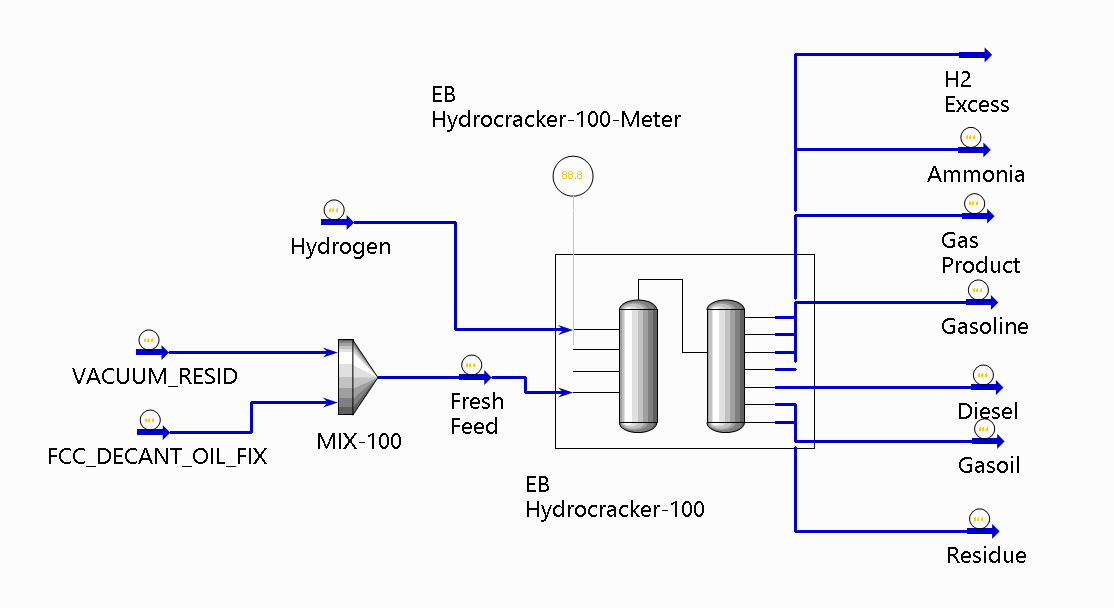Petro-SIM 7.1 Changes to Refinery Reactors
Key Highlights
- Introduced Biodiesel mode in DHTR-SIM to address corporate and legislative targets to introduce renewables for liquid fuels. KBC wants to support clients develop sustainable solutions
- In response to IMO 2020, many refiners have adopted high conversion residue technologies such as Ebullated-bed residue hydrocracking. To manage end-end value chain optimization, EBR-SIM is now embedded into the newest version of Petro-SIM
- Fluid characterization made even stronger tapping molecule level potential across the refinery-wide flowsheet
- In addition to introduction of HXX CDB feature last version, improved quench handling and property estimation bed-by-bed for modern mutli-bed reactors.
- Introduction of butylene selective ZSM to enhance the catalyst selection and optimization experience for FCC-SIM
- More improvements related to operational excellence and usability in FCC-SIM and HXX-SIM. For more details of each feature, please see below.
FCC-SIM
- Improved effluent curve matching during calibration via updated distillation handling
- Build on improvements in V7 with focus on matching input product distillations during calibration
- Option to have reactor predicted distillations based on carbon number data
- Eliminate unnecessary D86 distillation conversions and expanded number of distillation points predicted
- New technology activated by recalibrating after migration
- Introduced butylene selective ZSM-5 factors in addition to propylene selective ZSM-5 factors (refer screenshot below)

- Updated default settings:
- Yield Synthesis Method: TBP Cut Points and Distillations
- Octane and Sulfur Synthesis: FCC-SIM template
- Option to Reset Legacy Options during Calibration
- Enable easier migration to latest, recommended technology when recalibrating in latest version
FCC Usability and more informative reporting
Heat Balance Report
- Reporting of detailed regenerator and riser/reactor heat balance (refer screenshot below)

Enhanced Regen Targets view
- Clarified target selection (Combustion Target, Calculate Catalyst Cooler Duty)
- Includes input and calculated results side by side (refer screenshot below)

Detailed Diagram of the R-R section
- Collects information (inputs and results) of the same type such as heat flows or temperatures on the same page
- Organizes this information by location on a generic diagram of an FCC


Update of ZSM-5 in catalyst inventory input basis: wt% crystalline ZSM-5 or total additive particle wt%

New report variables
- Additional helpful ZSM-5 results

- Velocity report and new catalyst velocity results
- Riser WHSV and riser oil residence time
- Standard cut properties included in application workbook
HXX-SIM
Biodiesel Mode in DHTR-SIM
- First phase implementation with ability to co-process biofeeds (hydrogenated vegetable oil, animal fat, or other triglycerides from plant or animal sources) with refinery distillate streams into diesel hydrotreating model
- Incorporates new gaseous pure components (H2O, CO, CO2) into HXX-SIM
- Uses simplified representation in flowsheet for biofeeds based on heavy, narrow boiling range plus oxygen content input
- Includes heat effects of converting fatty acids, subsequent reactions of light gases (water gas shift, reverse methanation) and separations of new gases including solubility of CO2 in wash water
- Calibration of WGS and methanation to get measured CO and CO2 in recycle gas
- Ability to represent water in unit based on Effective Water Saturation T for Treat/Quench Gas
- Currently only supported for single reactor DHTR, and has no internal recycle

Improvements in Quench Handling
- Revamp quench options to support inter-bed heat removal via heat exchange and systems with no quench between beds, fitting new options into cascading scheme alongside existing handling of gas & liquid quench
- Update usability of existing and expanded quench feature for more explicit understanding of heat balance targets

HXX Usability and Reporting
Catalyst database
- Simplify usability regarding new v7 CDB feature to improve understanding and avoid user mistakes
- Ability to normalize RACs/CDB rate factors and ability to export CDB after calibration
All calibration options and HXX modes merged into a single view

More effluent properties results by bed
- WABT
- H2 PP
- Viscosity (V&L)
- Density (V&L)
- Vapor Fraction
- H2 Consumption per reaction
Fluid Characterization
- Introduced ability to switch to feed characterization at assay and flowsheet level
- Allow core PONA and sulfur type information to be originated by synthesis for feeds and assays and carried around in the flowsheet
- Standard Ca and Cn templates included (derived from laboratory NMR data) together with expansion in synthesis to generate aromatic ring profiles
- Sulfur types expanded for DHTR and CNHTR usage, default sulfur template for Mercaptan, Difficult, and Very Difficult sulfur included
- Feature needs to be turned on via Synthesis Settings
- Provides the the user major advantage in avoiding the need to segregate feeds to the FCC and Hydroprocessing reactors while building refinery wide flowsheets, leading to consistent results
- Has the potential of providing better stability in feed Ca/Cn predictions versus the current local estimation approach
REF-SIM
Hydrogen concentration term added to paraffin cracking kinetics
- Focussed at improving REF-SIM predictive capability for high pressure applications
AROM-SIM
New mole balance report
- Reports Alkyl and Phenyl values for feed and effluent and ratio of effluent:feed
Remove Predict Response factors
- Eliminates discontinuities in feed composition response and reactor inlet temperature
ALK-SIM
Updated RON kinetics and correlations for HFALK-SIM
- Improves 1-butylene alkylation octane response
Reactor wizard for new case setup for HFALK-SIM and SALK-SIM
EBR-SIM
Introduction of Ebullated bed reactor model
- The new EBR-SIM has been introduced in Petro-SIM version 7.1 to simulate conversion of heavy feedstocks such as residue. Ebullated-bed residue hydrocracking is a well-proven technology that creates value from even the most challenging residue feeds

Other improvements
Asphaltene yield tuning factor added to VGO Cracker model
Refinery Wide Sample Case now included
Reactor factor usability enhancement for FCC-SIM and DC-SIM
- Default values for tuning factors automatically populated
- Recognition of missing key calibration factors
Help Improvements
- FCC-SIM Calibration guidance
- DC-SIM Tech Manual updates and error message troubleshooting guidance